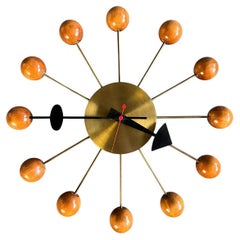Fritz Hansen More Clocks
When the Copenhagen-based furniture maker Fritz Hansen opened for business more than 140 years ago, the company — which today styles itself The Republic of Fritz Hansen — adhered to the traditional, time-honored Danish values of craftsmanship in woodworking and joinery. Yet thanks to the postwar innovations of Arne Jacobsen and others, Fritz Hansen would become the country’s leader in Scandinavian modern design using new, forward-looking materials and methods.
Fritz Hansen started his company in 1872, specializing in the manufacture of small furniture parts. In 1915, the firm became the first in Denmark to make chairs using steam-bent wood (a technique most familiar from birch used in the ubiquitous café chairs by Austrian maker Thonet). At the time, Fritz Hansen was best known for seating that featured curved legs and curlicue splats and referenced 18th-century Chippendale designs.
In the next few decades, the company promoted simple, plain chairs with slatted backs and cane or rush seats designed by such proto-modernist masters as Kaare Klint and Søren Hansen. Still, the most aesthetically striking piece Fritz Hansen produced in the first half of the 20th century was arguably the China chair of 1944 by Hans Wegner — and that piece, with its yoke-shaped bentwood back- and armrest, was based on seating manufactured in China during the Ming dynasty. (Wegner was moved by portraits he’d seen of Danish merchants in the Chinese chairs.)
Everything changed in 1952 with Arne Jacobsen’s Ant chair. The collaboration between the architect and Fritz Hansen officially originated in 1934 — that year, Jacobsen created his inaugural piece for the manufacturer, the solid beechwood Bellevue chair for a restaurant commission. The Ant chair, however, was the breakthrough.
With assistance from his then-apprentice Verner Panton, Jacobsen designed the Ant chair for the cafeteria of a Danish healthcare company called Novo Nordisk. The chair was composed of a seat and backrest formed from a single piece of molded plywood attached, in its original iteration, to three tubular metal legs. Its silhouette suggests the shape of the insect’s body, and the lightweight, stackable chair and its biomorphic form became an international hit.
Jacobsen followed with more plywood successes, such as the Grand Prix chair of 1957. The following year he designed the SAS Royal Hotel in Copenhagen and its furnishings, including the Egg chair and the Swan chair. Those two upholstered pieces, with their lush, organic frames made of fiberglass-reinforced polyurethane, have become the two chairs most emblematic of mid-20th-century cool. Moreover, the Egg and Swan led Fritz Hansen to fully embrace new man-made materials, like foam, plastic and steel wire used to realize the avant-garde creations of later generations of designers with whom the firm collaborated, such as Piet Hein, Jørn Utzon (the architect of the Sydney Opera House) and Verner Panton. If the Fritz Hansen of 1872 would not now recognize his company, today’s connoisseurs certainly do.
Find a collection of vintage Fritz Hansen tables, lounge chairs, sofas and other furniture on 1stDibs.
1960s Danish Mid-Century Modern Vintage Fritz Hansen More Clocks
Teak
1950s American Mid-Century Modern Vintage Fritz Hansen More Clocks
Brass
1950s American Vintage Fritz Hansen More Clocks
Hardwood
1960s Danish Mid-Century Modern Vintage Fritz Hansen More Clocks
Brass
1960s Unknown Mid-Century Modern Vintage Fritz Hansen More Clocks
Rattan
1950s American Mid-Century Modern Vintage Fritz Hansen More Clocks
Metal, Brass
Late 20th Century Mid-Century Modern Fritz Hansen More Clocks
Metal
1950s American Mid-Century Modern Vintage Fritz Hansen More Clocks
Metal, Brass
1950s American Mid-Century Modern Vintage Fritz Hansen More Clocks
Metal, Steel
Mid-20th Century Danish Mid-Century Modern Fritz Hansen More Clocks
Teak
20th Century Danish Mid-Century Modern Fritz Hansen More Clocks
Brass
1950s American Mid-Century Modern Vintage Fritz Hansen More Clocks
Ceramic
1950s American Mid-Century Modern Vintage Fritz Hansen More Clocks
Brass


